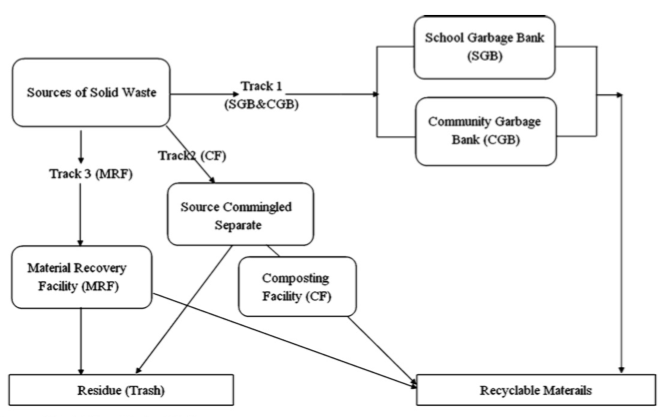In this section, we will be taking a closer look at one environmental behaviour/ practice in Thailand: Recycling of Waste Material. We will try to categorize this environmental practice and explain its success or failures.
Recycling of Waste Materials
Recycling is considered a behavior choice under the three categories of behavior proposed by Clayton and Myers. It is a practice that does not call for individuals to consume less. It simply asks that individuals consume at the same level, but with lesser environmental impact as waste materials are recycled.
In recent decades, the Thai government has channeled resources and efforts into improving the country’s waste management infrastructure.
However, only about 20% of over 15 million tons of annual generated household solid waste are being recycled when it is estimated that the potential recycling rate in Thailand should be as high as 40-60% (Shapkota et al., 2006).
It seems like even though recycling has been encouraged as a tool to reduce the harsh effects of excessive solid waste on environment and society, the current recycling participation rate in Thailand is still rather low.
Let’s examine why based on the factors influencing pro environmental behavior.
There are three fundamentally different types of recycling programs, or tracks, implemented in Thailand. The three tracks are illustrated in the diagram below:
Three Types of Recycling Programs Implemented in Thailand
Source: Adapted from Duston (1993)
Source: http://pattayamail.com/880/news.shtml
Source: http://www.redcross.org/portal/site/en/menuitem.1a019a978f421296e81ec89e43181aa0/?vgnextoid=8810dbe0fd0de110VgnVCM10000089f0870aRCRD
In the first track, individuals separate their waste into recyclables and waste and deposit them either at the School Garbage Banks (SGBs) or the Community Garbage Banks (CGBs).
In the second track, wastes are separated into compostables, recyclables, and non-compostables at the source. They are then further separated by different technologies and additives used.
In the third track, materials are sorted for recycling. However these materials are still mixed and are referred to as commingled. Commingled wastes are separated into recyclables and nonrecyclables by specialized equipment at a large, central facility called a material recovery facility (MRF).
Affordance
As mentioned, in the first track, individuals separate their waste into recyclables and waste and deposit them either at the SGBs or CGBs. SGBs and CGBs are established by the government to collect those recyclable materials and sell them to recycling buyers. There are about 500 schools in 30 provinces of Thailand that have implemented SGBs since 2001 (World Bank, 2003). There are also 300 CGBs across the entire nation.
Affordance is what is allowed or enabled by the physical or social environment that an individual is in (Clayton & Myers, 2009). Locating these SGBs and CGBs all over Thailand made it easier for the Thai people to recycle their waste as they now have a place where they can bring their recyclables to. And indeed, these SGBs recycle about a total of 2500 tons of recyclables per year (World Bank, 2003).
Reinforcement Contingencies
At the CGBs, recyclers are financially compensated for recyclable materials. The recyclers receive earnings for their recyclables depending on the weight and type of recyclable materials. ( Suttibak & Nitivattananon, 2008). This clearly is an incentive to the Thai people and hence encourages them to recycle their waste materials.
Attitudes
Based on what was discussed in the section Environmental Attitudes: Thailand, it was established that, for various reasons, the Thai people possibly hold pro environmental attitudes and hence are likely to participate in pro environmental behavior.
If affordances, attitudes and reinforcement contingencies point to the fact that Thai people are likely to recycle, why is it that their recycling rates are still so low?
Knowledge
It was challenging trying to find a proper syllabus for the environmental education in Thailand. It is suspected that there has yet to be an established one yet. And although I found some environmental campaigns that were done in Thailand to increase people’s environmental awareness (which can be found in the section of Environmental Attitudes: Thailand), it was impossible to find a campaign that was nation wide. Hence, I suspect that perhaps in terms of environmental knowledge, more can be done, especially where recycling is concerned. And perhaps, the lack of knowledge pertaining to recycling is one factor that contributed to the low recycling rates in Thailand.
Goals
Another reason for the low recycling rates in Thailand could be that waste management and recycling are not part of the Thai people’s priority or end goals in terms of environmental conservation. In a comparative study done by Kuribayashi and Aoyagi (1997), when Thai people were asked to give their opinions on what are the most pressing and important social issues in Thailand, their answers were environmental destruction accompanying economic development, inflation and traffic congestion. Clearly, if higher recycling rates and better waste management are not part of the Thai people’s goals, it would be tough getting them to participate in recycling.



